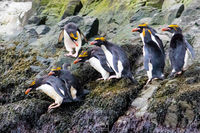Macaroni penguin
| Macaroni Penguin | |
|---|---|

| |
| Scientific classification | |
| Kingdom Information | |
| Domain | Eukaryota |
| Kingdom | Animalia |
| Subkingdom | Bilateria |
| Phylum Information | |
| Superphylum | Deuterostomia |
| Phylum | Chordata |
| Sub-phylum | Vertebrata |
| Infraphylum | Gnathostomata |
| Class Information | |
| Superclass | Tetrapoda |
| Class | Aves |
| Sub-class | Neornithes |
| Infra-class | Neognathae |
| Order Information | |
| Order | Spheniciformes |
| Family Information | |
| Family | Spheniscidae |
| Genus Information | |
| Genus | Eudyptes |
| Species Information | |
| Species | E. chrysolophus |
| Population statistics | |
| Population | 12,600,000+ (2018 est.)[1] |
| Conservation status | Vulnerable[2] |
The macaroni penguin (Eudyptes chrysolophus) is a species of penguin of the family Spheniscidae, and found in the extreme south of South America and on many sub-Antarctic islands.
Description
The macaroni penguin is large, standing about 28 inches tall, and weigh 7 to 8 pounds. Females are slightly smaller than males, and both will have fluctuations on weight during the year, weighing a maximum of 14 pounds just prior to the moult.
Adult birds are bluish-black above; below they are white, from the throat to the belly and legs. A white spot is present at the base of the upper tail. The plumage will have a brownish look just before moulting. The large and strong beak is a dark orange-brown, with vertical grooves sometimes present in older birds. A striking pink triangle of feathered skin runs from the base of the beak to the reddish eyes. Feet and legs vary from a flesh-colored tone to a strong pink with blackish soles. Juvenile birds are brownish in color with no to underdeveloped head crests; they reach sexual maturity in the fifth to sixth year of life.
The call is similar to that of other crested penguins, and are very common in the breeding colonies when the couples find each other and they establish their immediate nesting grounds[3]. Most calls consist of a loud and harsh bell sound and trumpet-like calls. The two parent birds the associated chick can be recognized by their voice, the exact nesting location plays no or only a minor role in finding the partner bird or chick. Local differences can be identified in the repertoire of calls. For example, the sounds of penguins which breed on South Georgia are faster in rhythm and somewhat higher. Males call a little longer and generally have a slightly lower voice.
The call includes short one-syllable calls that count as contact calls. Trumpet-like calls can be heard especially when the partners take turns in incubating the clutch. The calls of the chicks for the parent birds can only be distinguished one week after hatching.
Origins of the name
The name "macaroni" dates from mid-18th century Great Britain[4], with a club of fancy-dressed young men who were well educated and well traveled; they called themselves the "Macaroni Club", and were at various times accused of homosexuality[5]. The fashions that they wore - often flamboyantly exceeding the boundaries of men's fashions at the time - would include large feathers in their hats; this term would later be memorialized in the song "Yankee Doodle"[6][7]. The macaroni penguin was named as a result, the yellow crest feathers a reminder of the foppish hats of that club.
Range and habitat
The macaroni penguin is almost circumpolar, with breeding grounds on the sub-Antarctic islands of the Indian and Atlantic oceans between 46o and 65o southern latitude, and is usually north of the pack ice border. There is at least one breeding colony located on the Antarctic Peninsula. The area in which penguins live outside of their breeding season is pelagic, with vagrants sighted off the coasts of South Africa, Australia and New Zealand.
References
- ↑ https://www.iucnredlist.org/species/22697793/132602631#population
- ↑ https://www.iucnredlist.org/species/22697793/132602631
- ↑ https://www.xeno-canto.org/species/Eudyptes-chrysolophus
- ↑ https://www.merriam-webster.com/dictionary/macaroni
- ↑ http://rictornorton.co.uk/eighteen/macaroni.htm
- ↑ https://www.atlasobscura.com/articles/the-macaroni-in-yankee-doodle-is-not-what-you-think
- ↑ https://lifetakeslemons.wordpress.com/2011/05/02/how-a-yank-doodles-his-dandy-or-londons-macaroni-clubs/